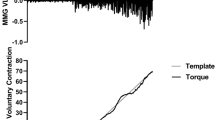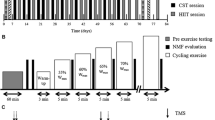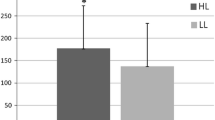Abstract
The study aimed to compare the activity of low and fast-twitch muscle fibers of the prime mover muscles used in cycling between recreational cyclists with different training levels during a high-intensity exercise. Twelve male cyclists performed, on distinct days, a graded exercise test and two bouts of cycling at severe-intensity. The first bout was performed as familiarization and the second to monitor the muscle activation through surface electromyography (EMG) of the rectus femoris, vastus lateralis, biceps femoris, and gluteus maximus. According to peak oxygen uptake \({(}\dot{V}{\text{O}}_{{{\text{2peak}}}} {)}\) and maximal aerobic power (MAP), participants were classified as untrained (\(\dot{V}{\text{O}}_{{{\text{2peak}}}}\) = 43.5 ± 1.2 mL kg −1 min −1, MAP = 3.3 ± 0.1 W kg −1) or recreationally trained (\(\dot{V}{\text{O}}_{{{\text{2peak}}}}\) = 53.7 ± 2.9 mL kg −1 min −1, MAP = 4.4 ± 0.4 W kg −1). During high-intensity exercise, the recreationally trained group presented higher area under the root mean square curve (p = 0.013, statistical power = 77%) and high-frequency content (p = 0.045, statistical power = 70%) for the rectus femoris EMG signal compared to the untrained group. Significant correlations (p ≤ 0.050) were observed between these EMG parameters and \(\dot{V}{\text{O}}_{{{\text{2peak}}}}\) (r ≥ 0.610), MAP (r ≥ 0.647), and respiratory compensation point intensity (r ≥ 0.833). We conclude that overall and fast-twitch motor unit recruitment capacity of the rectus femoris is modified by the endurance training status and may play an important role in aerobic fitness level in cycling.




Similar content being viewed by others
Abbreviations
- \(\dot{V}{\text{O}}_{{2}}\) :
-
Oxygen uptake
- \(\dot{V}{\text{O}}_{{{\text{2peak}}}}\) :
-
Peak oxygen uptake
- \(\dot{V}_{{\text{E}}} {/}\dot{V}{\text{CO}}_{{2}}\) :
-
Ventilatory equivalent of carbon dioxide
- [La−]peak :
-
Peak blood lactate concentration
- AUC:
-
Area under the curve
- EMG:
-
Surface electromyography
- GXT:
-
Graded exercise test
- HR:
-
Heart rate
- RCP:
-
Respiratory compensation point
- MAP:
-
Maximal aerobic power
- MDF:
-
Median frequency
- RMS:
-
Root mean square
- Δ60%:
-
60% Of the difference between maximal aerobic power and respiratory compensation point intensity
References
Faria EW, Parker DL, Faria IE (2005) The science of cycling: Physiology and training—part 1. Sport Med 35:285–312
Abbiss CR, Laursen PB (2005) Models to explain fatigue during prolonged endurance cycling. Sport Med 35:865–898
De Luca C (1997) The use of surface electromyography in biomechanics. J Appl Biomech 13:135–163
Wakeling JM (2008) Spectral properties of the surface EMG can characterize motor unit recruitment strategies. J Appl Physiol 105:1671–1673
Von Tscharner V (2002) Time-frequency and principal-component methods for the analysis of EMGs recorded during a mildly fatiguing exercise on a cycle ergometer. J Electromyogr Kinesiol 12:479–492
Diefenthaeler F, Bini RR, Vaz MA (2012) Frequency band analysis of muscle activation during cycling to exhaustion. Rev Bras Cineantropometria e Desempenho Hum 14:243–253
Coyle EF, Feltner ME, Kautz SA et al (1991) Physiological and biomechanical factors associated with elite endurance cycling performance. Med Sci Sports Exerc 23:93–107
De Pauw K, Roelands B, Cheung SS et al (2013) Guidelines to classify subject groups in sport-science research. Int J Sports Physiol Perform 8:111–122
Dutra YM, Claus GM, Malta EDS et al (2020) Acute Photobiomodulation by LED does not alter muscle fatigue and cycling performance. Med Sci Sports Exerc 52:2448–2458
Kuipers H, Verstappen FTJ, Keizer HA et al (1985) Variability of aerobic performance in the laboratory and its physiologic correlates. Int J Sports Med 6:197–201
Binder RK, Wonisch M, Corra U et al (2008) Methodological approach to the first and second lactate threshold in incremental cardiopulmonary exercise testing. Eur J Cardiovasc Prev Rehabil 15:726–734
Bishop D (2003) Warm Up II. Sport Med 33:483–498
Hermens HJ, Freriks B, Disselhorst-Klug C et al (2000) Development of recommendations for SEMG sensors and sensor placement procedures. J Electromyogr Kinesiol 10:361–374
Lanferdini FJ, Bini RR, Baroni BM et al (2018) Improvement of performance and reduction of fatigue with low-level laser therapy in competitive cyclists. Int J Sports Physiol Perform 13:14–22
Wakeling JM, Horn T (2009) Neuromechanics of muscle synergies during cycling. J Neurophysiol 101:843–854
Field A (2005) Discovering statistics using SPSS, 2nd edn. Sage Publications, London
Cohen J (1988) Statistical power analysis for the behavioral sciences, 2nd ed. Routledge, New York
Kraemer WJ, Marchitelli L, Gordon SE et al (1990) Hormonal and growth factor responses to heavy resistance exercise protocols. J Appl Physiol 69:1442–1450
Mangine G, Hoffman JR, Gonzalez AM et al (2015) The effect of training volume and intensity on improvements in muscular strength and size in resistance-trained men. Physiol Rep 3:e12472
Vila-Chã C, Falla D, Farina D (2010) Motor unit behavior during submaximal contractions following six weeks of either endurance or strength training. J Appl Physiol 109:1455–1466
Ando R, Kondo S, Katayama K et al (2019) Neuromuscular activation of the knee and hip extensor muscles during high-intensity interval and moderate-intensity constant cycling. J Electromyogr Kinesiol 44:64–69
Camata TV, Altimari LR, Bortolotti H et al (2011) Electromyographic activity and rate of muscle fatigue of the quadriceps femoris during cycling exercise in the severe domain. J Strength Cond Res 25:2537–2543
Johnson MA, Polgar J, Weightman D, Appleton D (1973) Data on the distribution of fibre types in thirty-six human muscles. An autopsy study. J Neurol Sci 18:111–129
Hawley JA, Stepto NK (2001) Adaptations to training in endurance cyclists: Implications for performance. Sports Med 31:511–520
Blake OM, Wakeling JM (2012) Muscle coordination during an outdoor cycling time trial. Med Sci Sports Exerc 44:939–948
Faul F, Erdfelder E, Lang AG, Buchner A (2007) G*Power 3: A flexible statistical power analysis program for the social, behavioral, and biomedical sciences. Behav Res Methods 39:175–191
Karlsson S, Yu J, Akay M (2000) Time-frequency analysis of myoelectric signals during dynamic contractions: A comparative study. IEEE Trans Biomed Eng 47:228–238
Wang L, Wang Y, Ma A et al (2018) A comparative study of EMG indices in muscle fatigue evaluation based on grey relational analysis during all-out cycling exercise. Biomed Res Int 2018:9341215
Farina D, Merletti R, Enoka RM (2004) The extraction of neural strategies from the surface EMG. J Appl Physiol 96:1486–1495
Farina D, Holobar A, Merletti R, Enoka RM (2010) Decoding the neural drive to muscles from the surface electromyogram. Clin Neurophysiol 121:1616–1623
Savelberg HHCM, Van de Port IGL, Willems PJB (2003) Body configuration in cycling affects muscle recruitment and movement pattern. J Appl Biomech 19:310–324
Scattone Silva R, Purdam CR, Fearon AM et al (2017) Effects of altering trunk position during landings on patellar tendon force and pain. Med Sci Sports Exerc 49:2517–2527
Blackburn JT, Padua DA (2009) Sagittal-plane trunk position, landing forces, and quadriceps electromyographic activity. J Athl Train 44:174–179
Funding
Fundação de Amparo à Pesquisa do Estado de São Paulo, #2017/11255-0, Yago Medeiros Dutra, Coordenação de Aperfeiçoamento de Pessoal de Nível Superior, 001, Alessandro Zagatto
Author information
Authors and Affiliations
Corresponding author
Ethics declarations
Conflict of interest
The authors declare that they have no competing interests.
Ethical approval
All experimental procedures were approved by SGT University (reference number SGT/FPHY/2021/431A) and were conducted in accordance with the Declaration of Helsinki. All participants completed all evaluation, and none were excluded from the analysis phase.
Informed consent
Before initiating any procedure, participants were informed of the possible risks and benefits of the study and only began evaluations after signing a written consent form.
Additional information
Publisher's Note
Springer Nature remains neutral with regard to jurisdictional claims in published maps and institutional affiliations.
Supplementary Information
Below is the link to the electronic supplementary material.
Rights and permissions
About this article
Cite this article
Dutra, Y.M., Lopes, V.H.F., Brisola, G.M.P. et al. Rectus femoris activation is modified by training status and correlates with endurance performance in cycling. Sport Sci Health 18, 1415–1425 (2022). https://doi.org/10.1007/s11332-022-00925-0
Received:
Accepted:
Published:
Issue Date:
DOI: https://doi.org/10.1007/s11332-022-00925-0




